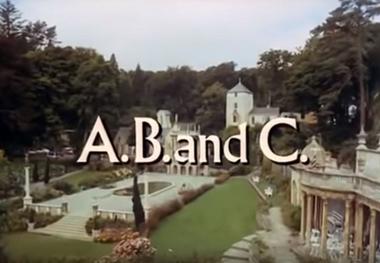
Rewind & Rewatch: The Prisoner – A. B. and C.

I will start the third episode rewatch with my prologue from the first episode–as a caveat and introduction. I’ll put this intro into an indented section to make it easier for people who’ve read it to skip it and get to the current episode.
I am starting a Rewind & Rewatch series on The Prisoner (the 1967 British series, created by Patrick McGoohan and George Markstein and starring McGoohan). I’ll be following the DVD episode order throughout this rewatch. In this series, I am merely looking for things of interest to me, ideas I find striking. This series is decidedly not a comprehensive review of The Prisoner, and these are certainly not my final thoughts on the TV series. It’s more like a set of notes. With any good piece of art, one can continually come back to it and find fecundity: missed elements, new relevancies, new avenues for thought. And, of course, there is already quite a bit of media surrounding the series, e.g., Time for Cakes and Ale has a separate podcast (“The Tally Ho”) reviewing the episodes, there is a fantastic website dedicated to the show (The Unmutal Website, which has articles and links to more writing about the show)–and, of course, there are numerous pop culture references to it. Despite all of this great content, I still feel compelled (for the sheer love of the show) to demonstrate my deficiencies! So, here we go…
We see Colin Gordon as Number Two (he plays Number Two in “The General” as well, and, like Leo McKearn, is the only actor to play the character twice in the series). The vulnerability of his character is evident in his first extended scene: he is not ‘indispensable’ and it shows (for one, in the on-the-nose, oddly shaped red-colored phone that becomes our symbol of that danger for his character).
The psychological bent of the show continues–explicitly in the display of Number Six’s (single-minded) thoughts. Of course, one need not look too far to see the prescience of the portrayal of this type of technology. The ability to translate thoughts into words and images is at our fingertips: ‘mind-reading’ AI can now translate thoughts into words and images. For examples of some articles on this, and as a start, one can look to the following:
https://www.media.mit.edu/articles/watch-this-device-translate-silent-thoughts-into-speech/
https://fortune.com/2019/05/07/artificial-intelligence-mind-reading-technology/
But this technology is a combination of other technologies–i.e., this aforementioned thought projection, virtual reality, and mind control, to name a few. While still in the realm of science fiction today, does anyone doubt where this might apply to our world now? One need only look at the popular (and different) works of Nicholas Carr, Evgeny Morozov, or Jaron Lanier to find resonances worth exploring.
Again, the play with reality is evident–Number Six wakes from his first ‘dream’ to see Number 14 (whom he recognizes) and his mark from the shot he received. Is it real? Whom do we trust? Again, the narrative is clearly with the protagonist here–and the audience is to sympathize with him.
A. tries to get the information primarily through force (with a bit of sly, tricky wordplay to start).
B. tries to get the information primarily through pleasures (alcohol, sexual enticement, dance), for ‘tonight’s a party’–and, then, through her fear and need of protection. Of course, this is manipulation by Number 14 in the last instance. And it is told to the audience that Number 2 and Number 14 can’t make the ‘dream images’ say what they want; the dream must play out as Number Six’s unconscious mind would have it–that is, until Number 14 has the idea to insert herself (her voice) into the dream. But this only adds to Number Six’s suspicions that the ‘dream’ is not real.
C. is revealed through luck, chance (and the gambling plays as an obvious symbol for this, as well as the levels of game playing by Number Six and Number 2 & 14). However, the ‘dream’ with C. is not fully realized because of Number Six’s thwarting of the plan through dilution of the soporific drug. At the point of discovery, we come to a door that must be unlocked (is it another obvious symbol of the unconscious?). Once they enter, the screen goes black. Nothing. The ‘dream’ picks up again with C. and Number Six driving (after Number 2 and Number 14 risk his life to resume the ‘dream’). We meet a masked figured–revealed to be Number 2. And in the reveal, we see Number Six has been playing them all along–manipulating the manipulators.
We come back to the images that started his ‘dreams’ at the beginning of the manipulation–the tenaciousness of Number Six, his one-track mind, once again fully on display.
I wonder what this progression says? About the psychology of Number Six (e.g., the projections are, at least in part, from the mind of Number Six)? About human psychology (again, the play between individualism and mind manipulation/group conformity)? About the manipulators?
Thanks for reading–and I’ll be back soon to continue my rewatch of The Prisoner. “Be seeing you”…




